Menus
- Z is angry
- Power, taste and revving
- Not only angry, but also practical in everyday life
- The tightening cure is noticeable
- Powerful steering behavior (page 2)
- The most angry Z ever
- facts and figures
- engine
- landing gear
- measurements and weight
- Service data
- Set up
- MOTORCYCLE readings
- Ten years of the Kawasaki Z 1000
- MOTORCYCLE points evaluation and conclusion
- engine
- landing gear
- everyday life
- security
- costs
- Overall rating and conclusion
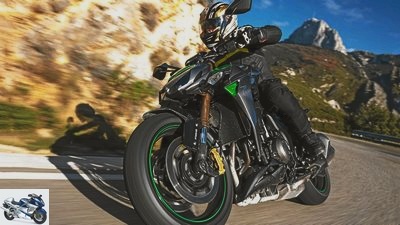
www.
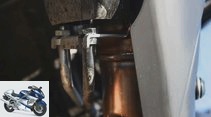
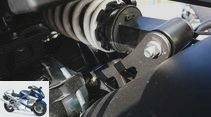
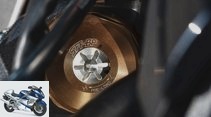
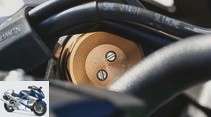
29 photos
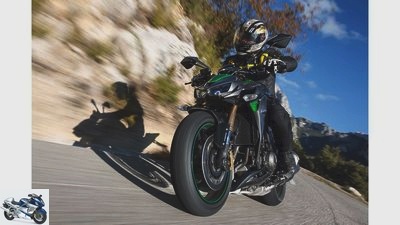
www.
1/29
Radical, eye-catching and powerful, a Z has to be somehow, thought the responsible engineers and designers of the latest creation of the Z family.
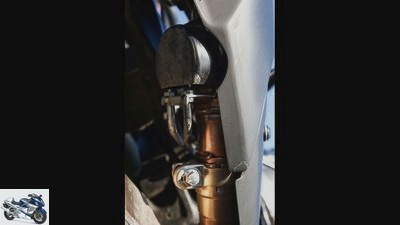
www.
2/29
Only on the right-hand silencer does an exhaust flap do its job relatively inconspicuously.
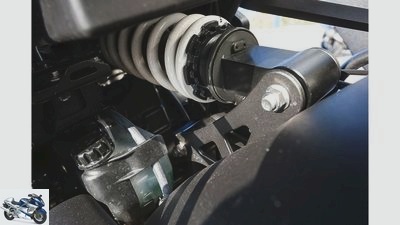
www.
3/29
The horizontal strut is articulated via a lever that is now more progressive and dampens tightly.
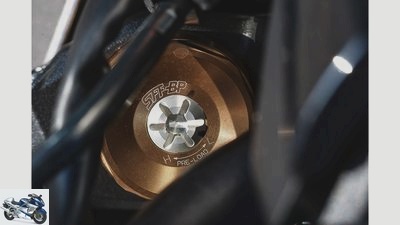
www.
4/29
With the new Big Piston fork, both the spring base (on the left fork plug)…
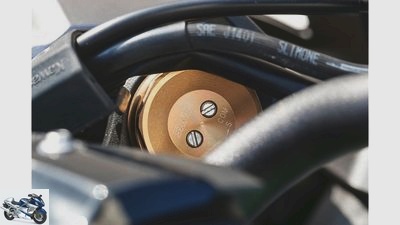
www.
5/29
.. as well as the rebound and compression damping (on the right fork plug) can be easily adjusted from the handlebars. It also looks really classy.
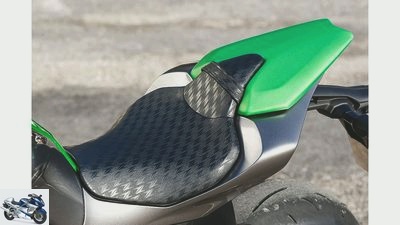
www.
6/29
The tight driver’s seat cushion was decorated with many small Z, the passenger comfort is shockingly low.
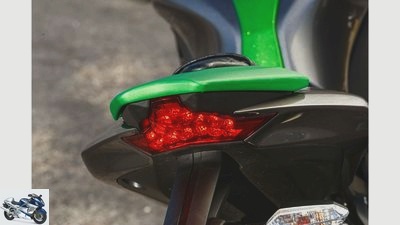
www.
7/29
The rear light of the Kawasaki Z 1000.
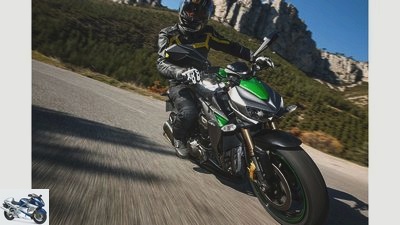
www.
8/29
The 1000s do not know a starting weakness. From 1000 revolutions the four-cylinder starts powerfully and already exceeds the limit of 80 Newton meters at 2500 revolutions.
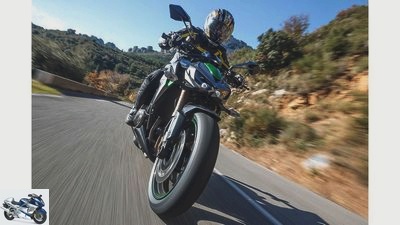
www.
9/29
In the standardized consumption lap, the muscle man approved 5.2 liters per 100 kilometers. A satisfactory value in relation to the smoke provided by the unit.
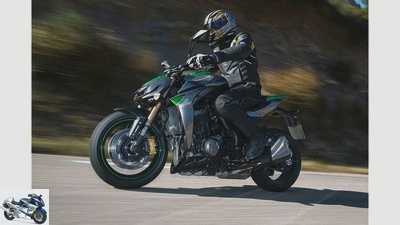
www.
10/29
The Kawa engineers have tinkered a lot with the chassis and decided against comfort and a tightening cure.
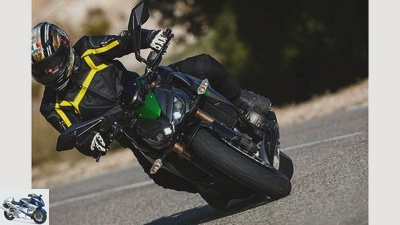
www.
11/29
You can feel the effects of the tightening cure right away. The Kawa grinds its way through the track in a sporty and firm manner, is exactly in its element on asphalt asphalt and irons jaggedly through the botany.
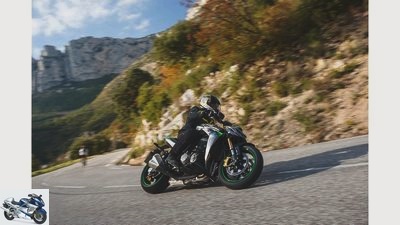
www.
12/29
However, the steering behavior is not completely convincing. With a clear impulse, the Kawa has to be balanced in an inclined position in order to keep it on course with a lot of counter pressure on the inside of the handlebars.
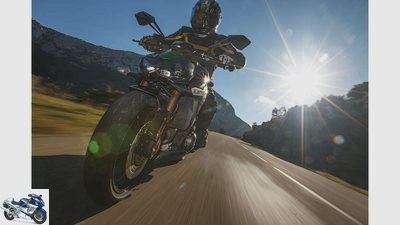
www.
13/29
The handiness of the 222 kilogram bike is okay either way. The rims, which are 1.5 kilograms lighter than their predecessor, have a positive effect.
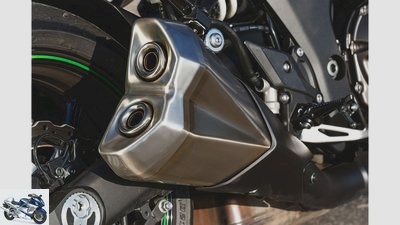
www.
14/29
Anyone who thinks of bland mashed potatoes when they hear the word four-cylinder should try this four. It comes with fiery spice and a guttural-growling sound from the newly designed airbox.
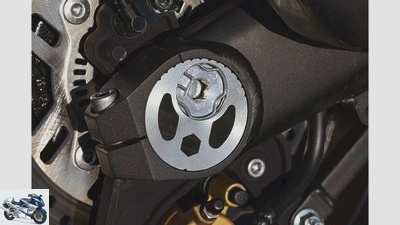
www.
15/29
Fine detail: the eccentric adjustment of the rear wheel axle is both visually and functionally impressive.
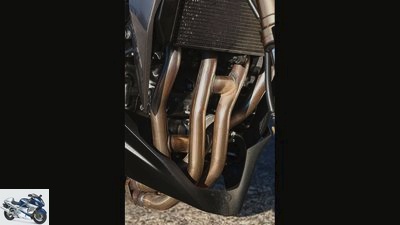
www.
16/29
The interference tubes between the manifolds are now oval and offer a higher throughput.
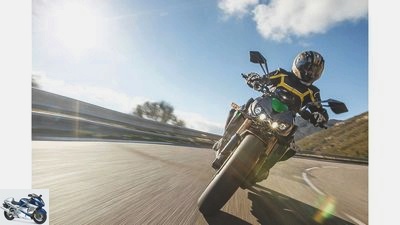
www.
17/29
What is the name of the new philosophy of the Z generation? Quite simply: Away with Bionade and vegan low-fat-cost, on with beer, sausages and biceps.
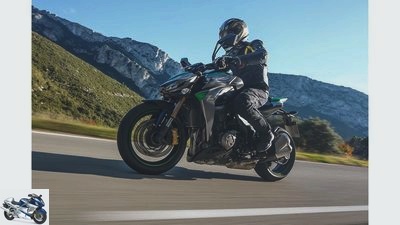
www.
18/29
With the new Z 1000, a real freak around the corner who wants to be grabbed by the horns is roasting. You shouldn’t stroke this kawa like your mother-in-law’s lap dog, but dominate it like a stallion kicking around.
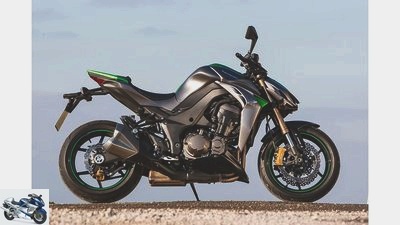
www.
19/29
You don’t need a lot of imagination to realize that a big cat was the dominant role model in the design line.
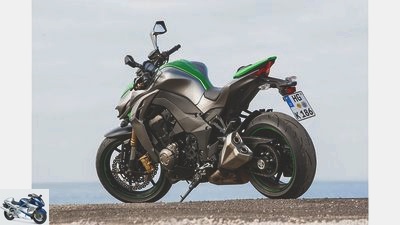
www.
20/29
The design polarizes like no other and is without a doubt the most extreme thing you can currently find on the market.
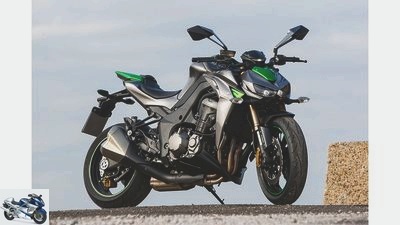
www.
21/29
From a distance, when looking into the low-hanging and organically accentuated lamp mask with LED headlights, one suspects an alien on a kamikaze course, from close up a previous frontal crash.
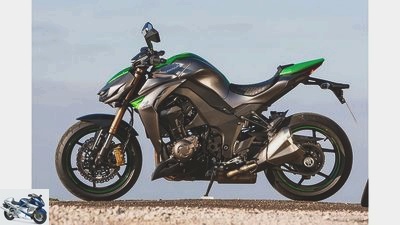
www.
22/29
The Kawa people call this Sugomi, which means something like awesome aura.
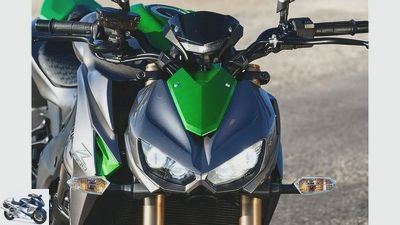
www.
23/29
Well, it’s just a matter of taste.
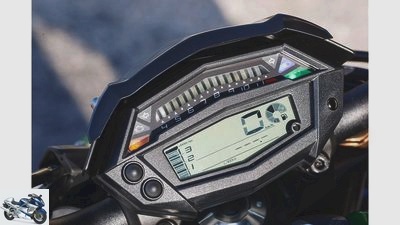
www.
24/29
Up to 4000 tours the LCD takes over the task of the rev counter, above that the bright LED treadmill.
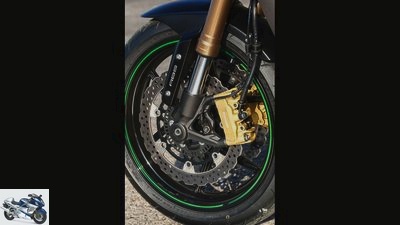
www.
25/29
Braking made easy: The fixed piston calipers from Tokico decelerate really well.
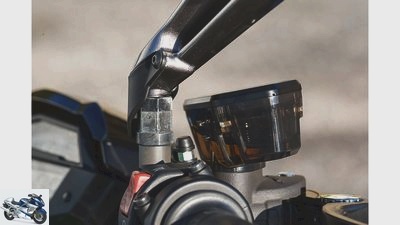
www.
26/29
The brake fluid reservoir made of transparent plastic is a nice design gimmick and simplifies checking the level.
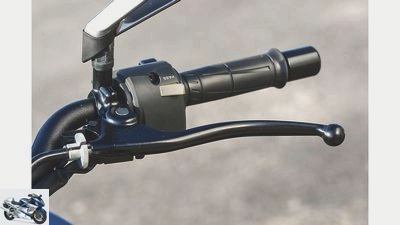
www.
27/29
The attachment of the two-legged rearview mirror makes its adjustment unnecessarily complicated. There is a plastic cover over the fastening and counter nut. This has to be removed first if you want to adapt the mirror to individual preferences.
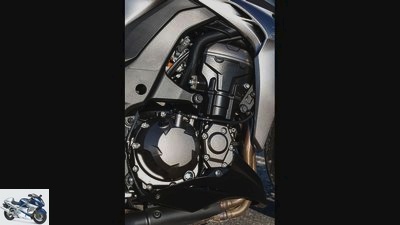
www.
28/29
The engine does not hide behind strange descriptions, but enthusiastic from the start. The engine with a displacement of 1043 cubic centimeters was largely taken over from the previous model.
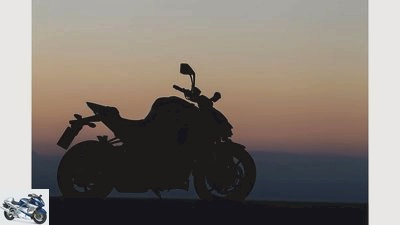
www.
29/29
If you push the Kawasaki Z 1000 into the corner with a lot of force, you will also be delighted with a huge portion of driving fun. Hopefully this philosophy will also find many new followers.
Top test: Kawasaki Z 1000 Special Edition
Z is angry
The new Kawasaki Z 1000 completes the generation change and elevates the sporting tradition of the ancestral gallery to the most angry level that has ever existed.
A real KLaunching the awasaki Z 1000, which combines the virtues of an extreme athlete with the design of an aggressive naked bike, is no easy task. After all, Kawasaki’s Z models have preserved and transported the core of the Kawasaki image for over four decades.
Buy complete article
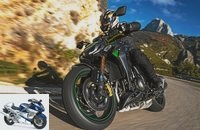
Top test: Kawasaki Z 1000 Special Edition
Z is angry
Kawasaki Z 1000. Not a softly washed everyday product, but a nasty bike with the allure of a wild beast.
One can be skeptical. Because you don’t have to have studied business administration to know that the focus of a product in a specific niche has to rely on accommodating the wishes of the customer. To put it more simply: every philosophy needs followers if it is to be successful.
The new philosophy of the new Kawasaki Z 1000 is: Away with Bionade and vegan low-fat food, with beer, steaks and upper arms. With the new Kawasaki Z 1000, a real freak is roasting around the corner who wants to be grabbed by the horns. You have to dominate him like a kicking stallion.
To embody exactly this image, people in Japan have worked hard. The biggest change is easy to see. The design polarizes like no other and is without a doubt the most extreme thing you can currently find on the market. From a distance, when looking into the low-hanging and organically accentuated lamp mask with LED headlights, one suspects an alien on a kamikaze course, from close up a previous frontal accident. The Kawa people call this Sugomi, which means something like awesome aura.
Power, taste and revving
Fortunately, the engine of the Kawasaki Z 1000 is not hidden behind strange descriptions, but enthusiastic from the start. The engine with a displacement of 1043 cm³ was largely taken over from the previous model. In addition to a revised mapping and additional connecting channels in the crankcase, the valve timing has been modified and the lift of the intake valves slightly reduced. The latter is supposed to give the engine more steam in the lower and middle speed range.
The changes to the periphery hit the same line. The length of the intake funnel was standardized, the cross-section of the interference pipes between the manifolds was increased and the final transmission was shortened by adding one more tooth to the rear chainring. In return, the sixth gear was designed for longer in order to keep the speed level identical to that of the predecessor at the same speed.
During the test run, the Kawasaki Z 1000 shows a peak performance that has increased by 3 to 141 hp and a maximum torque of 112 Newton meters. In practice, all measures are expressed in three ways: Power, taste and revving in every situation! The tester’s heart seldom rejoiced more often. One turn of the conventionally controlled throttle using Bowden cables, and the Kawa subito rolls up its sleeves to head for the next bend.
In spite of the double throttle valves, the case is rough on the gas, which requires a certain amount of time to get used to. The Kawasaki Z 1000 catapults you motivated towards the horizon with the slightest pull on the whisk and conveys a Japanese zest for life.
Subscribe to MOTORRAD videos on Youtube
Not only angry, but also practical in everyday life
www.
Up to 4000 tours the LCD takes over the task of the rev counter, above that the bright LED treadmill.
The Kawasaki Z 1000 does not have a weakness in starting. The four-cylinder kicks off powerfully from 1000 rpm and already exceeds 80 Nm at 2500 rpm. At 5500 it pulls the driver’s arms longer and longer and reaches its torque zenith at 7400 rpm. The receipt: bearish thrust, front wheel prancing across the ground and constant risk of losing your driver’s license. Any questions?
However, this drive can be mastered well. Finally, it increases its performance evenly, depends directly on the gas and ignites two emotional fireworks in the middle. It comes with fiery flavor and a guttural-growling sound from the newly designed airbox. Whether it will stay at this high level?
The transmission of the Kawasaki Z 1000 can be operated properly. It certainly won’t win a prize, but you don’t have to use enormous force to switch, nor are the paths noticeably long. You only have to attest to a certain boneiness.
The view of the command center, including the LCD cockpit and LED tachometer, appears futuristic and high-quality. The displays are easy to read, with information such as the range and average consumption, the on-board computer even offers everyday practical virtues. And while we’re at it: In the standardized consumption lap, the muscle man approves 5.2 liters per 100 kilometers. A satisfactory value in relation to the smoke provided by the unit.
The seating position of the Kawasaki Z 1000 also turned out to be practical in everyday life. Acceptable knee angle, slightly front-facing seating position, new, pleasantly cranked aluminum handlebars, quite firm seat upholstery: the Z 1000 has a great workplace for the pilot. The petrol tank, which has grown by two to 17 liters, is tall, but remains nice and narrow in line with the thighs and allows good contact with the bike. The mirrors have been designed with double struts with great attention to detail. They offer a good view of the traffic behind you.
The tightening cure is noticeable
www.
Braking made easy: The fixed piston calipers from Tokico decelerate really well.
But why should the Z 1000 actually be the angriest of all time? The uncompromisingly tight basic set-up is noticeable as soon as you sit down. The Kawa engineers have tinkered a lot with the chassis and decided against comfort and a tightening cure. On the one hand, the shock absorber with adjustable spring base and rebound damping received a new damping setup, and the deflection was designed for a higher progression. The wheelbase was reduced by five and the caster by two millimeters. The Big Piston fork from Showa is brand new, and although it houses a spring in each of the two bars, the left half is responsible for adjusting the spring preload, while the right half is responsible for adjusting the rebound and compression damping. The adjusting screws are located on the corresponding fork plug.
You can feel the effects of the tightening cure right away. The Kawa grinds its way through the track in a sporty and firm manner, is in its element on asphalt asphalt and irons jagged through the botany. Thanks to its excellent responsiveness, it absorbs light bumps very well, only when there are successive transverse joints there is unrest in the front end. Basically, a tighter setting means higher reserves. However, too much damping can also have the exact opposite of a good roadholding. If you shoot over the target, the fork or shock absorber does not rebound quickly enough. If the next shock immediately follows, the spring element only acts in the most progressive part of its work area. In the case of the Kawa, this leads to a slight rocking of the motorcycle. Reducing the rebound damping of the shock absorber and fork brought at least a slight relief.
Aside from the tight basic character of the chassis, there is another noticeable feature. If MOTORRAD was presented with a Z 1000 with a fork slightly pushed through (compared to the delivery state) a few weeks earlier at the presentation in Seville, Spain, the motorcycle also came to the editorial office for this test with that setup.
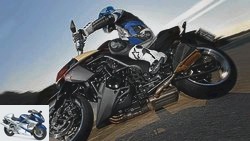
Exhaust & silencer
Product test: exhaust systems for the Kawasaki Z 1000
Accessory silencer for Kawasaki’s naked bike
read more
All used offers: Kawasaki Z 1000
Powerful steering behavior (page 2)
www.
However, the steering behavior is not completely convincing. The Kawa has to be balanced in an inclined position with a clear impulse in order to keep it on course from then on with a lot of counter pressure on the inside of the handlebars.
In this configuration, however, the steering behavior is not completely convincing. With a clear impulse, the Kawa has to be balanced in an inclined position in order to keep it on course with a lot of counter pressure on the inside of the handlebar end. The front wheel constantly tends to collapse when it is inclined. In practice, this peculiarity becomes noticeable through additional arcs when choosing a curve. In general, the Kawa comes across a stretch with a smooth curve. She is reluctant to poke tight turns. Nevertheless, the power-consuming steering behavior goes well with the Z. Anyone who heats a day with this coordination through botany has not only come to terms with it, but can also save himself the gym in the evening. At least the forearms have already completed their daily workload. After a correction of the fork to the level of the series condition, the stiff and unruly steering behavior does not disappear completely, but the forces required are significantly lower. Now you wag the Kawa from curve to curve much more playfully, enjoying the more homogeneous steering behavior and wondering what could have induced the Kawa people to lower the steering head by a few millimeters.
But once in a while, this question answers itself. When a full pound is accelerated from an incline, it only takes a small impulse for the handlebars to fidget. Since the Z 1000 does not have a steering damper, you have to reckon with steering knocking in extreme situations. So it’s better to go down a bit with the steering head and train your forearms. Already fits!
The most angry Z ever
www.
The engine does not hide behind strange descriptions, but enthusiastic from the start. The engine with a displacement of 1043 cubic centimeters was largely taken over from the previous model.
The handiness of the 222 kilogram bike is okay either way. The rims, which are 1.5 kilograms lighter than their predecessor, have a positive effect. Even if the tires (Dunlop D214) and the format of the rear tire spoil a better performance of the Kawa. The 190 tire comes with a 50 mm cross-section that is no longer up-to-date. Its flat contour promotes straight-line stability and increases the tire contact area, but this format is not conducive to handling. Unfortunately, the tires also produce a strong righting moment when braking into corners. But once brought to the right temperature, they stick well to the asphalt and enable unheard of inclines. The assumption, which can be heard from many corners, that the rear silencers, which have been slightly revised in appearance, scratch the floor early on, can be safely forgotten. The Kawasaki did not even touch down on countless test kilometers.
The brakes are very successful and the performance is significantly improved. With the latest Bosch ABS, contemporary monoblock brake calipers from Tokico and a brake disc ten millimeters larger, the Kawa decelerates with vehemence. Thanks to a larger piston in the master brake cylinder and an adapted lever ratio, the operating forces remain low. Two fingers are enough even for emergency braking. Congratulations, Kawa – that’s how it should feel when you drop an anchor! With great grip, however, you have to be careful, then the rear wheel tends to lift off due to the strong braking effect.
As expected, there is nothing to complain about on the processing side of the Kawa. Perhaps more in terms of price. At 12,195 and 12,395 euros for the special edition (gold anodized brake calipers, green and silver paintwork), the Japanese naked bike is not a bargain. Especially with regard to the technologically significantly higher quality competition from Bavaria. But that’s out of the question for real fans anyway. You will undoubtedly receive the most angry Z ever in the latest generation. If you force them into the corner with a lot of force, you will also be happy with a huge portion of driving fun. Hopefully this philosophy will also find many new followers.
facts and figures
www.
Anyone who thinks of bland mashed potatoes when they hear the word four-cylinder should try this four. It comes with fiery spice and a guttural-growling sound from the newly designed airbox.
engine
Water-cooled four-cylinder four-stroke in-line engine, a balance shaft, two overhead, chain-driven camshafts, four valves per cylinder, bucket tappets, wet sump lubrication, injection, Ø 38 mm, regulated catalytic converter, 336 W alternator, 12 V / 8 Ah battery, mechanically operated multi-disc oil bath clutch , Six-speed gearbox, O-ring chain, secondary ratio 43:15.
Bore x stroke: 77.0 x 56.0 mm
Displacement: 1043 cc
Compression ratio: 11.8: 1
Rated capacity: 104.5 kW (142 hp) at 10,000 rpm
Max. Torque: 111 Nm at 7300 rpm
landing gear
www.
Fine detail: the eccentric adjustment of the rear wheel axle is both visually and functionally impressive.
Backbone frame made of aluminum, load-bearing motor, upside-down fork, Ø 41 mm, adjustable spring base, rebound and compression damping, two-arm swing arm made of aluminum, central spring strut, lying, with lever system, adjustable spring base and rebound damping, double disc brake at the front, Ø 310 mm, four-piston Fixed calipers, rear disc brake, Ø 250 mm, single-piston floating caliper, ABS.
Cast aluminum wheels: 3.50 x 17; 6.00 x 17
Tires: 120/70 ZR 17; 190/50 ZR 17
Tires in the test: Dunlop D 214 “T”
measurements and weight
Wheelbase 1435 mm, steering head angle 65.5 degrees, caster 101 mm, spring travel f / h 120/122 mm, permissible total weight 401 kg, tank capacity 17.0 liters.
Service data
Service intervals: 6000 km
Oil and filter change: every 12,000 km 3.8 liters
Engine oil: SAE 10W-40
Telescopic fork oil: Kawasaki SS-47
Spark plugs: CR9EIA-9
Idle speed: 1100 ± 50 rpm
Tire pressure solo (with pillion passenger) front / rear: 2.5 / 2.9 (2.5 / 2.9) bar
Guarantee: two years
Colour: Green / black
Price: 12395 euros
Additional costs: 180 euros
Set up
Country road
| fork | |
| Rebound | 5.00 revolutions |
| Pressure level | 8.00 revolutions |
| preload | 6.25 turns * |
| Air pressure | 2.5 bar |
All turns from closed position
counted out.
* Counted from a fully relaxed position
| Strut | |
| Rebound | 0.5 turns |
| preload | 10.2 millimeters |
| Air pressure | 2.9 bar |
MOTORCYCLE readings
BILLION
The engine power of the Kawasaki Z 1000.
Performance
| Top speed | 237 km / h |
| acceleration 0-100 km / h 0-140 km / h 0-200 km / h |
3.2 sec 5.1 sec 10.0 sec |
| Draft 60-100 km / h 100-140 km / h 140-180 km / h |
2.9 sec 3.0 sec 3.1 sec |
| Speedometer deviation effectively |
48/97 km / h |
| Tachometer deviation Display red area effectively |
11000 rpm 10800 rpm |
consumption
| Country road | 5.3 l / 100 km |
| at 130 km / h | 6.2 l / 100 km |
| theoretical range country road | 321 km |
| Fuel type | Super |
mass and weight
| L / W / H | 2060/900/1230 mm |
| Seat height | 815 mm |
| Handlebar height | 1010 mm |
| Turning circle | 6400 mm |
| Weight with a full tank | 222 kg |
| Payload | 179 kg |
| Wheel load distribution v / h | 50.2 / 49.8% |
BILLION
The measured values of the transmission of the Kawasaki Z 1000.
transmission
The pulling power, the power and torque curves speak for themselves. Even from the lowest speeds, the Kawa pushes forward powerfully and develops its power exactly where it is needed most: in the middle. Only after 9500 tours do the propulsion and ease of turning ebb. But if you leave the gas in this region, you are beyond the StVO anyway.
BILLION
The braking behavior of the Kawasaki Z 1000.
The Kawasaki Z 1000 has a completely revised brake system, which has a positive effect. The latest generation of Bosch ABS controls at fine intervals and enables brilliant deceleration. The best braking effect is achieved with the Kawa if you do not build up the brake pressure abruptly, but carefully apply the brake for the first few meters.
Ten years of the Kawasaki Z 1000
www.
The Kawasaki Z 1000 from 2007: four-cylinder in-line engine, 953 cm³, 92 kW (125 hp) at 10,000 rpm, 99 Nm at 8,200 rpm, steel backbone frame, engine supporting, tank capacity 18.5 liters, total weight 235 kilograms.
Evolution of the bad boy
The first Z 1000 saw the light of day in this millennium over ten years ago. It should revive the former image of the bad boy bikes. She has succeeded in this since the third generation at the latest. The birth of the Z family of course began in 1973 when Kawasaki put the legendary 900 Z1 on the counter. It is still considered the original image carrier of the manufacturer, which since then has been largely defined by power and speed.
So it came as no surprise when, at the turn of the millennium, they returned to these virtues and designed a motorcycle that many fans of the brand had been waiting for for a long time: a naked bike with the power of a genuine super athlete. The four-cylinder engine of the first modern Z 1000 actually came from the ZX-9R, but thanks to the larger bore it has a proud 953 cubic centimeters of displacement and produced a robust 127 hp. However, it got a bit weak on the chest especially in the lower speed range and thus lagged far behind the competition. On the chassis side, however, it was able to convince with neutral driving characteristics. Even their rough edges were already causing a riot. The striking four-in-four exhaust system was also a tribute to the ancestor
The successor came onto the market in 2007 with a lower peak performance, but with smaller ducts, a revised cylinder head and a shorter gear ratio, it completely eliminated the weakness of its predecessor. Above all, there was criticism of the chassis, which had to be meticulously adjusted and was sensitive to changes in damping and preload. In addition, the die-hard fans in particular criticized the somewhat too tame character. Kawasaki reacted and put a lot on it with the successor in 2010.
The performance of the completely new engine rose to a generous 138 hp without missing the smoke in low speed regions. The rather long-stroke design of the drive and the further shortened gear ratio gave the last generation of the Z 1000 a fiery draft. Unfortunately, she also suffered from stubborn turning behavior in corners.
MOTORCYCLE points evaluation and conclusion
www.
It’s not a bargain, but the Kawasaki Z 1000 is a bike with a lot of sporting spirit.
engine
| Maximum score |
Kawasaki Z 1000 Special edition |
|
| Draft | 40 | 38 |
| acceleration | 40 | 33 |
| Top speed | 30th | 20th |
| Engine characteristics | 30th | 26th |
| Responsiveness | 20th | 12th |
| Load change | 20th | 14th |
| Smoothness | 20th | 12th |
| coupling | 10 | 9 |
| circuit | 20th | 13 |
| Gear ratio | 10 | 9 |
| Start | 10 | 8th |
| total | 250 | 194 |
The Kawa scores well in this chapter. The torque of the four-cylinder and the relatively short overall ratio make the Z 1000 a real pull-through star. It is almost fantastic how calmly and yet emotionally the unit delivers its performance. The snappy response of the engine to gas commands takes getting used to. Vibrations can be clearly felt from 6000 revolutions, but never get to the fore. The clutch deserves praise with its easy operating forces and precise release point.
landing gear
| Maximum score |
Kawasaki Z 1000 Special edition |
|
| Handiness | 40 | 25th |
| Stability in turns | 40 | 25th |
| Steering behavior | 40 | 22nd |
| feedback | 10 | 6th |
| Inclined position | 20th | 16 |
| Straight-line stability | 20th | 14th |
| Suspension tuning in front | 20th | 13 |
| Chassis set-up at the rear | 20th | 13 |
| Adjustment options undercarriage | 10 | 5 |
| Suspension comfort | 10 | 4th |
| Driving behavior with a passenger | 20th | 14th |
| total |
250 |
157 |
The handiness of the Z 1000 benefits from the 1.5 kilogram lighter rims. In terms of steering behavior and stability in curves, however, the Kawa has to give up. On the one hand, the impulse to turn has to be carried out vigorously; on the other hand, the bike needs to be held in line with a lot of force on the handlebars. If both the fork and the shock absorber respond to unevenness, their damping in the basic setup is a bit too tight. The Z 1000 is of course not comfortable.
everyday life
| Maximum score |
Kawasaki Z 1000 Special edition |
|
| Ergonomics driver | 40 | 28 |
| Ergonomics pillion | 20th | 7th |
| Windbreak | 20th | 1 |
| view | 20th | 13 |
| light | 20th | 9 |
| Furnishing | 30th | 15th |
| Handling / maintenance | 30th | 17th |
| Luggage storage | 10 | 1 |
| Payload | 10 | 4th |
| Range | 30th | 19th |
| processing | 20th | 14th |
| total |
250 |
128 |
The pilot’s workplace impresses with a discreetly sporty note and appropriate ergonomics. The pillion comfort, however, fell by the wayside. At best, the seat roll is sufficient for narrow hips. The LED headlights look great, but they only illuminate the roadway selectively. They lack scattering power, so using the bike at night is not necessarily recommended. As expected, the processing is at a high level.
security
| Maximum score |
Kawasaki Z 1000 Special edition |
|
| Braking effect | 40 | 33 |
| Brake metering | 30th | 26th |
| Braking with a passenger / fading | 20th | 14th |
| Righting moment when braking | 10 | 5 |
| ABS function | 20th | 14th |
| Handlebar slapping | 20th | 11 |
| Ground clearance | 10 | 7th |
| total |
150 |
110 |
The brake is finely dosed and requires little manual effort. It is more than gratifying that their performance has increased thanks to a modern ABS, the fixed piston calipers and a larger disc. However, this does not apply to the Kawasaki’s tendency to flap the handlebars. A corresponding steering damper would do well at this point. Unfortunately this is missing.
costs
| Maximum score |
Kawasaki Z 1000 Special edition |
|
| guarantee | 30th | 15th |
| Consumption (country road) | 30th | 18th |
| Inspection costs | 20th | 10 * |
| Maintenance costs | 20th | 7th |
| total |
100 |
50 |
| * Inspection times based on the previous model, as not yet announced by the manufacturer |
||
The consumption of 5.2 liters is slightly below that of the direct competitors. Inspection intervals of (probably) 6000 kilometers are no longer up to date.
Overall rating and conclusion
| Maximum score |
Kawasaki Z 1000 Special edition |
|
| Overall rating |
1000 |
639 |
| Price-performance note |
1.0 |
2.3 |
In absolute terms, the Z 1000 is a motorcycle with a lot of sporting spirit that needs to be moved accordingly. Again, it is not a bargain.
Conclusion
Extremely designed, extremely sporty, extremely demanding. The updated Z 1000 is the angriest version of its model history. She needs a lot of attention, a driver with a penchant for extravagance and muscular upper arms. If you don’t mind the somewhat stubborn steering behavior, the Kawasaki will always put a smile on your face. It will be interesting to see how the Kawa will fare against the competition this year.
Related articles
-
Comparison test: Honda CB 1000 R, Yamaha FZ1, Triumph Speed Triple, Kawasaki Z 1000
Comparison test: Honda CB 1000 R, Yamaha FZ1, Triumph Speed Triple, Kawasaki Z 1000 Large naked bikes in comparison Contents of …
-
Triumph Tiger 1050 Sport against Kawasaki Z 1000 SX in comparison test
17 pictures 1/17 Comparison test between Kawasaki Z 1000 SX and Triumph Tiger 1050 Sport. 2/17 Faster wheel changes thanks to …
-
Comparison test sports tourer Kawasaki Z 1000 SX Tourer, Triumph Sprint GT
www. 35 pictures www. 1/35 Sports tourers sit between all chairs, but the temptation lies in this niche: there are bikes, …
-
Honda CB 1000 R, Kawasaki Z 1000 SE, Yamaha FZ1 in the test
www. 48 photos www. 1/48 On the MOTORRAD test tracks in southern France, Honda’s CB 1000 R and Yamaha’s FZ1 are ready to test…
-
Kawasaki J 300 Special Edition in the driving report
Kawasaki 25 pictures Kawasaki 1/25 Kawasaki 2/25 Kawasaki 3/25 Kawasaki 4/25 Kawasaki 5/25 Kawasaki 6/25 Kawasaki 7/25 Kawasaki 8/25 Kawasaki 9/25 Kawasaki …
-
Jahn Top test Aprilia Tuono 1000 R Everything stays different The Tuono is not just a naked bike. It’s a super sports naked bike. She always was. But the…
-
Comparison test BMW S 1000 RR, Kawasaki ZX-10R and Yamaha YZF-R1M
22 images 1/22 BMW S 1000 RR, Kawasaki Ninja ZX-10R and Yamaha YZF-R1M. 2/22 Yamaha YZF-R1M. 3/22 BMW …
-
Comparison test BMW K 1300 S, Kawasaki ZZR 1400, Suzuki Hayabusa 1300
Gargolov comparison test BMW K 1300 S, Kawasaki ZZR 1400, Suzuki Hayabusa 1300 Speedbikes in comparison The wind tunnel shaped their faces, their beefy …
-
Kawasaki ZX-10R and BMW S 1000 RR in a comparison test
www.bilski-fotografie.de 25 pictures www.bilski-fotografie.de 1/25 Let’s first take a look at the new Kawasaki ZX-10R. www.bilski-fotografie.de …
-
Kawasaki Z 1000 in the driving report
Kawasaki 34 pictures Kawasaki 1/34 Dirty, brutal, extreme. The new Z 1000 has its eyes on evil. Kawasaki 2/34 Kawasaki 3/34 Kawasaki 4/34 Kawasaki …